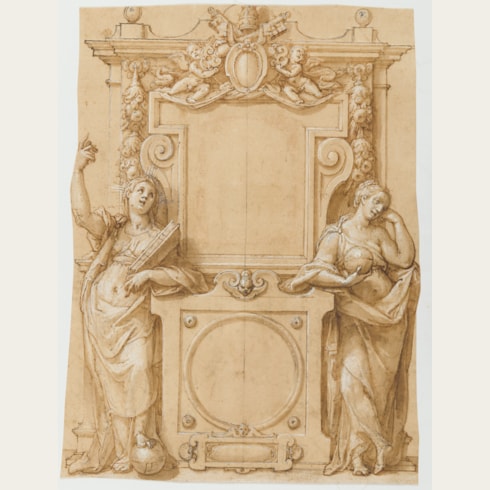Federico ZUCCARO
(Sant’Angelo in Vado c.1540/41 - Ancona 1609)
The Martyrdom of Saint Lawrence
Made up at the lower corners, and laid down.
530 x 285 mm. (20 7/8 x 11 1/4 in.) at greatest dimensions.
James Mundy has kindly confirmed the attribution of the present sheet, and has noted that it is an autograph version or copy of another drawing by Federico Zuccaro, of similar dimensions, in the collection of the Uffizi in Florence. He further suggests that the present sheet and the Uffizi drawing, which both show significant differences from the finished painting, particularly in the background, should be regarded as studies for the Fermo altarpiece, for which no other preparatory drawings are known.
This drawing bears the collector’s mark of the Cypriot art dealer and collector Nicos Dhikeos (1896-1987), who had settled in France by 1916. He lived in Lyon, where he owned a gallery dealing in Old Masters, and from 1930 onwards assembled a large and varied group of Old Master and 19th Century drawings, primarily of the Italian and French schools. While much of his collection were acquired at auction, Dhikeos also bought large groups of drawings from the heirs of the 20th century collectors Dr. A. Tardieu and Louis Maudet. The drawings were largely dispersed in the years following Dhikeos’s death in 1987, and sheets from the collection are today in the British Museum in London, the J. Paul Getty Museum in Los Angeles, the Metropolitan Museum of Art and the Pierpont Morgan Library in New York, the Louvre in Paris and the National Gallery of Art in Washington D.C., among many other institutions.
Federico Zuccaro was among the most well travelled artists of his day. Unlike Taddeo, he travelled throughout Italy, working in Venice, Florence, Orvieto, Bologna, Urbino, Pavia, Turin, Parma and Mantua, while also visiting France, the Netherlands and England between 1574 and 1575. On his return he received a commission to complete the decoration of the cupola of the Duomo in Florence, begun by Vasari and completed by Zuccaro between 1576 and 1579. The next year he was back in Rome, contributing to the decoration of the Cappella Paolina of the Vatican, before departing for Venice, where he worked between 1582 and 1584. He established a particular practice of making drawings after works of art that he saw on his journeys; a sort of visual travel diary that attests to a broad and wide-ranging interest in the different schools of painting in Italy. (As the Zuccaro scholar James Mundy has noted, ‘Federico was completely without prejudice in his omnivorous ingestion of the work of other artists, both past and present.’) In 1585 he was summoned by Philip II to Spain, where he painted eight canvases for the retablo mayor, or high altar, of the Basilica of San Lorenzo at El Escorial, as well as cloister frescoes in the attached monastery. Elected the first principe of the reorganized Accademia di San Luca in 1593, Zuccaro continued to receive important commissions late into his career. He built a fine palace for himself in Rome, now the home of the Biblioteca Hertziana. Near the end of his career he wrote an artistic treatise entitled L’idea de’ pittori, scultori et architetti, published in 1607.
A gifted draughtsman, Federico Zuccaro was much influenced by the drawings of his elder brother, particularly early in his long career. However, as Julian Brooks has noted, ‘Federico’s style was less dramatic than Taddeo’s, and he answered the demands of the Catholic Church for a clearer, more iconic art. His drawings and compositions are tidier than those of Taddeo, with less robust figures, a greater interest in decorative effects, and occasionally complex iconography.’ Furthermore, Federico’s peripatetic career, together with his inveterate copying of the work of other artists, exposed him to a wider range of artistic influences, which often found their way into his drawings and paintings. As Mundy has pointed out, ‘Whereas it would be fair to say that Taddeo’s style was invented in Rome, Federico’s was forged in an international crucible…The wide stylistic range of drawings might be expected but it still, at times, surprises the viewer.’
Provenance
Galerie Terrades, Paris, in 2016
Private collection.








